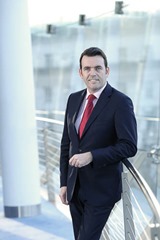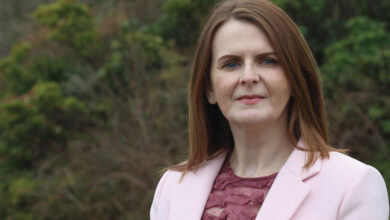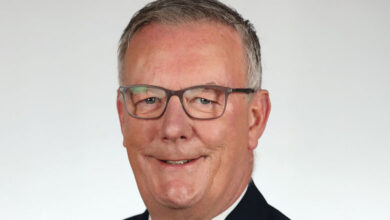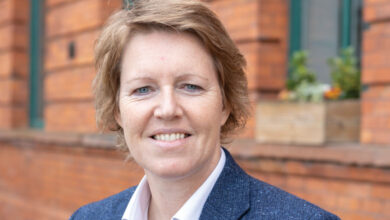Defining digital
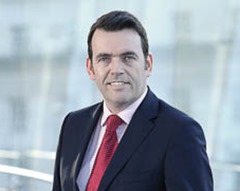 Matt McCloskey, Sales Director with eircom Business Solutions NI, discusses Northern Ireland’s progress on using digital to transform public services and its future prospects with
Matt McCloskey, Sales Director with eircom Business Solutions NI, discusses Northern Ireland’s progress on using digital to transform public services and its future prospects with
Owen McQuade. The region can become an effective pioneer if organisations capture the benefits of digital and reassure customers about privacy.
The changing shape of IT and telecoms is opening up the potential to connect citizens to public services in a more intuitive way, according to Matt McCloskey, but there is now a need for organisations to define what is meant by ‘digital’ in the context of delivering public services.
“The private sector has led the way in how to define digital but, in the last five or six years, the public sector has very much caught up,” McCloskey remarks. “Times have changed and a significant amount of IT advancement has taken place.” Network NI is a great example of a converged network with unified communications in central government and eircom is now working to bring the newly merged local councils on to similar single networks. Not so long ago, convergence and unified communications were future technologies and “were previously at the beginning of the Gartner hype-cycle” but they are now “ubiquitous” and the Civil Service is a model example of this foundational technology. All of this allows organisations to converge and share services on a single network which is smart enough to prioritise real-time communications such as voice and video over other communications such as email. It also allows them connect to the internet at high speeds over a single managed internet connection from the main site rather than multiple low bandwidth connections. So IP is now ubiquitous, unified communications are mainstream and bandwidth is cheaper than ever.
Digital DNA
Taking a step back, it’s worth asking if the job is done. “Industry in general has presided over a significant amount of channel shift where a service, which previously involved an interaction by telephone or in person, now happens online,” he continues. “That has resulted in great savings and better customer experience. However, it must be asked: ‘To what extent does channel shift really change the way an organisation operates and the services it offers? And how deep does the digital DNA actually go within the organisation?’”
McCloskey recalls how some private sector clients would set up a new website where customers would request a service online but the back-end process was manual. “Everything looked smooth to the person who was interacting but at the back end, it actually wasn’t a digital service,” he comments. “It was the same point solution that had always been there albeit there was now a nice web front-end.”
A truly digital organisation is not just one which uses the latest technology but one which takes digital “as a thread of DNA through everything that they do.” This runs from using data analytics and insight to understand what customers or citizens want; to spot trends enabling new services to be designed that are customer-centric, needs-based and are truly digital from end-to-end; and then monitoring these services, getting feedback from customers and redesigning as appropriate.
“In order to do that,” McCloskey adds, “organisations need to mature beyond leaving everything digital to a traditional IT department and digital needs to become a board-level mission for the whole organisation that transcends all departments.” Each head of department would have specific responsibilities regarding digital and the concept would be considered in every aspect of the organisation’s work. As a result, digital will be seen as an organisational task rather than an IT task: “The technology is there today but there is a cultural shift required to make the most of that technology to create truly digital organisations with everyone thinking about how technology can be used to create digital services.”
Journey
In general, he sees Northern Ireland as having been “at the vanguard” in this space, having been ahead of the rest of the UK in the first steps. Network NI and then NI Direct were great steps towards providing the backbone to allow the Northern Ireland Civil Service to work smarter and a high quality digital front-end service provision for the public to interact with.
“A lot of the services on NI Direct are about channel shift and reducing the number of transactions and there has been great success. Looking forward, I think this is surely just the beginning of the journey to embed digital throughout the organisations and drive new value-added digital services to citizens. The Enterprise Shared Services’ strategy has highlighted this,” he comments. The focus of this work is around mobile as a channel and designing services that allow people to interact in the way that they prefer.
Northern Ireland central government is on the right path and local government is now following. The councils are now reducing the barriers which held up progress in the past and the whole public sector must now consider “how to look across central and local government and take a citizen-centric and holistic approach to services.” There are “fantastic opportunities” in local government and the sector can also learn lessons from the change process in central government.
Asked about how IT is perceived in organisations, McCloskey notes that five years ago, many IT departments were seen as the part of the organisation that held up progress by resisting new trends such as flexible working and ‘bring your own device’ or keeping an operating system that was clearly out-of-date: “It was very much there to defend processes and security and not to look at the business as a whole or drive new value.”
Times have changed and he does not see that as a tenable attitude in today’s world. By 2025, in his view, any organisation which doesn’t get digital “just won’t exist.” McCloskey highlights one local success story, Chain Reaction Cycles in South Belfast, which is now the world’s largest online bike store: “We’re now in a world where digital almost is the business and therefore we can’t afford to have a reactive IT department.” Instead, there is a need for a ‘digital department’ which helps the rest of the organisation to understand technology and gives it the freedom to make decisions and come up with new digital ideas that will transform the organisation.
One of the interesting recent organisational trends is the transition from Chief Information Officer to Chief Digital Officer (CDO). In England, some local councils have taken this approach, where the CDO is a board level appointee who focuses on the value of digital to the organisation, cultural changes and business outcomes, rather than always looking to cut IT expenditure. In some cases, the CDO is asking for additional investment as digital services can and will deliver more savings across the entire organisation, better services, increased revenue and efficiency.
“It’s a transformative role,” McCloskey reflects. “Perhaps in 10 years, we won’t need a Chief Digital Officer but I think there’s still a mission for that role in most private sector organisations. There’s also a great opportunity in the public sector – central and local – to really embrace this new way of thinking and really go through this 5-10 year period of transformation.” Ideally, a public sector organisation will be much more agile in 2025 than it is in 2015.
Procurement
In some ways, IT procurement is also undergoing much change with new frameworks for the Public Services Network (PSN) and G Cloud becoming more prevalent.
He maintains: “The Cabinet Office is focused on making it easier for public sector to procure services in a low cost and speedy way and, at the same time, drive best value from the market while allowing SME organisations a chance to compete.” Both PSN and G-Cloud help organisations to gain best value in the market and procure for modular elements that they need in a very quick and efficient way that reduces cost and complexity and gives them access to a choice of the latest technologies to achieve their outcomes.
“Certainly, 10 years ago, you might have been in a two-year procurement for a managed services contract with a highly complex and convoluted process and commercial negotiations, and then be locked into that contract for 10 years,” McCloskey adds. “What we have now is a lot more flexibility, simpler processes and greater choice and value.”
Expectations and trust
A recent Deloitte survey indicates that only 3 per cent of citizens would avoid digital altogether but 33 per cent were worried about the risks involved in using those channels. McCloskey comments that the network, mobile presence and virtualisation are in place but it’s important to consider if the demand is there.
“The survey very clearly points out that citizens want to use this technology and engage with the public sector in a different way,” he surmises. “Eighty-eight per cent of the people surveyed said that they would relish the opportunity to engage in a more interactive way with public services. The appetite to engage with government is an opportunity but people are worried about whether data will be safe and that’s still a concern.”
The answer, in his view, is in being open, upfront and transparent with customers, clearly defining the services and what they are for, and clearly articulating the common standards for security that will protect citizens’ data.
“In our private lives as consumers, we have fantastic technology that would be unthinkable a few years ago, we have smartphones that automatically upload photos to the cloud,” McCloskey adds. “We can video-conference with relatives all over the world at no cost and with simple touchscreen commands. When we go into work the next day, we expect the similar, easy-to-use effective technology as employees, and businesses and public sector organisations are now catching up with that.”
Similarly, people may come to expect a transaction with the public sector to be as easy as one with Amazon. The logical consequence is to expect a government service to recognise the customer’s identity, hold data about them and offer services that are relevant to them. “We’ve a long way to go to get to that,” he remarks, “but I think the network and the technology are there at the moment and with the right cultural change, I think there’s a massive opportunity – particularly for Northern Ireland – to really engage with this technology and transform how we operate.”
Digital leadership
In terms of size and population, Northern Ireland is geographically similar to Estonia which is often viewed as one of Europe’s digital leaders. “There is an opportunity, if the will is there, for Northern Ireland to make a strategic decision to excel in the digital space,” McCloskey states. “The skills that we would build in doing so would be exportable and transferable to the private sector as well. Northern Ireland could be a fantastic exemplar case study for the rest of the UK for how you can transform citizen services using technology to create a truly digital sector.”
Profile: Matt McCloskey
Born in Ballymena, Matt graduated in philosophy from Queen’s University Belfast in 1994 and then left for London. A 20-year career in telecoms followed, from sales and operations to product management and product development, and latterly in a number of senior commercial roles across consumer and business markets. He rose to being Head of Product, Pricing and Propositions at Virgin Media responsible for UK-wide B2B markets and then decided to relocate back to Northern Ireland last July for family reasons. Matt is kept busy with two children aged two and four, is a keen amateur photographer and enjoys travel and the outdoors, especially in Donegal.
Website: www.eircom.co.uk

